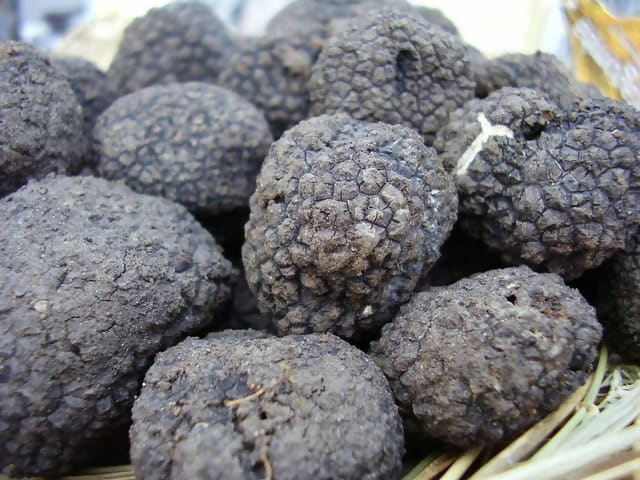A Guide to Mushroom Nutrition: Functional Fungi for Your Health

Introduction to Mushrooms: The third food kingdom we should all be eating!
Neither plants nor animals, fungi are in their own unique classification domain. Whereas plants photosynthesize their own food with chlorophyll, and animals ingest their food, mushrooms flourish by breaking down decaying organic matter or growing on various substrates in the right temperature and humidity conditions. Mushrooms are commonly lumped in with other vegetables, but they are truly unique in their lifecycle and constituents.
Also unlike plants and animals, mushrooms contain tough cell walls made of chitin. Chitin is a fibrous polysaccharide that makes up the exoskeleton of crustaceans like crabs and lobsters as well as insects. It is mostly indigestible when eaten raw, but cooking breaks them down and lets us access all of the beneficial bioactive constituents found in the mushroom. Mushrooms are resilient to a wide range of cooking times thanks to those tough cell walls, which makes for lots of flexibility when cooking with other ingredients.
There are over five million species of mushrooms known to exist today, and many mycologists agree that there are many more to still be discovered. About 2,000 varieties are known to be edible, with large fruiting bodies. While many are found seasonally in the wild, mushrooms are also commonly grown on commercial substrates such as grain, wood, and rice (especially in China). This makes them a very sustainable food source. Many mushroom farms are family-owned and operated and can easily utilize the byproducts of other agricultural sectors as a substrate to incubate mushroom mycelia. Indoor mushroom production is energy efficient, does not take up much space nor use much water, and affords great control over environmental factors.[1]
According to recent data from the Food and Agricultural Organization of the United Nations, the output of global mushrooms has soared to over 47 million tons in 2016, making mushroom consumption one of the most quickly growing sustainable food items in the world.
The Amazing Nutritional Content of Mushrooms
Mushrooms are an excellent source of several vitamins and minerals
Mushrooms provide a wide range of nutrients found in both animals and plants, which makes them a great addition and/or replacement to many items on the plant and animal-dominated food pyramid recommended by the Food and Drug Administration (FDA).
Mushrooms are a good source of the B-complex vitamins. This includes thiamine (B1), riboflavin (B2), niacin (B3), pantothenic acid (B5), and folate (B9). The exact ranges of these vitamins depend on the specific mushroom variety, but in one serving of crimini, the Percent Daily Value of these B-complex vitamins range from 5%-27%. Mushrooms are particularly an excellent source of riboflavin, at 27% DV. These vitamins are very important for blood cell formation, cellular metabolism, proper nervous system functioning, and energy levels. Some mushroom varieties, such as shiitake, golden chanterelle and black trumpet, contain active forms of vitamin B12. Researchers believe it is the bacteria present on the surface of these mushrooms that manufacture it, but the jury is still out on whether or not the levels present can correct a B12 deficiency, which typically requires fortified foods, animal products, or supplemental forms.
While animals use cholesterol as a component of cellular membranes, mushrooms utilize sterol and ergosterol. The ergosterol found in mushrooms is a precursor to Vitamin D. When mushrooms are exposed to UV light, they produce over 100% DV of vitamin D2. Wild varieties are known to have higher concentrations of D2 compared to commercially grown mushrooms which are typically grown in the dark unless they are specifically treated with UV light to maximize levels of vitamin D. One can increase the levels of vitamin D found in mushrooms by simply exposing them sliced to sunlight for as little as fifteen minutes.[1] Recent research has found that the ingestion of 2000IU of vitamin D2 from mushrooms is as bioavailable as ingesting 200IU of D2 from supplements. Both forms raised and maintained blood vitamin D levels, and mushrooms had the added benefit of being a great source of D3 and D4 as well. [2] In addition to B-vitamins and vitamin D, mushrooms also provide a good source of vitamin C and vitamin E.
Mushrooms are a great source of several minerals such as selenium and copper (34%-40% DV in one serving), and a decent source of potassium, zinc, and manganese (4-7% DV in one serving). These minerals are important for a wide range of bodily processes, from building strong bones to making hormones, transmitting nerve impulses, and maintaining normal growth and development.
Mushrooms contain protein and unique amino acids like Erogothioneine
Mushrooms are a great, bioavailable source of the hard-to-come-by amino acid ergothioneine, containing more than ten times the amount found in any other food. This sulfur-containing compound is not synthesized by animals, and so has to be acquired through diet. It accumulates in the kidney, liver, and bone marrow of animals, and can be found in beans, oat bran, and some species of bacteria.
Ongoing research is still determining its precise functional role in human health, but given that the compound has its own unique transport system in the body, it is implicated in many important cellular processes. Preliminary research has found that the amino acid has antioxidant properties and may play a key role in preventing oxidative stress, which is associated with a wide range of diseases and health conditions. The amino acid may also participate in ion transport and regulation of some enzymes.
Apart from this amino acid, leucine, valine, glutamine, glutamic acid, and aspartic acids are the most abundant amino acids present in edible mushrooms.
USDA guidelines say 10-35% of caloric intake should be from protein. The minimum threshold is reached by many mushrooms, and some even exceed it. White button mushrooms are the most protein-dense on a calorie by calorie basis (3.09g per 100g), whereas oyster mushrooms have the most protein on a per weight basis (3.3 grams per 100g).
Mushrooms are a good source of natural fiber
Fiber is important in the diet because it has laxative effects, blood glucose- and cholesterol-stabilizing effects, and helps feed the beneficial microbes present in the gut. The community of these microbes constitutes the microbiome. Being part of the enteric nervous system, the microbiome is sometimes called the “second brain” because of its crucial importance in regulating neurotransmitter levels, immune system function, and inflammation, to name a few things. These bacteria proliferate by feeding on soluble and insoluble fiber and in the process, create their beneficial metabolic byproducts, which are able to cross from the bloodstream to the central nervous system and regulate many cellular processes. Additionally, beneficial bacteria in the gut can help in the absorption and utilization of many vitamins and minerals, including calcium and minerals. For this reason, adding mushrooms to dishes can aid in getting the most out of the nutritional content of other ingredients.
The average adult needs approximately 25-38g of fiber per day based on FDA guidelines, but this number depends on factors such as age and sex.
Mushrooms are about 35%-70% carbohydrates by dry weight. Most of this is in the form of non-digestible carbohydrates such as chitin and other novel polysaccharides such as beta-glucan. The form of this fiber is mostly water-insoluble, with only about 10% being soluble fiber.
Beta-glucans have been the subject of intensive research in modern times, and have been associated with a range of beneficial health effects for humans. This includes regulating blood cholesterol and blood sugar, improving innate and adaptive immunity, and preventing the growth and proliferation of cancerous cells.[3]
Mushrooms do contain fiber, but they are not an excellent source of it. For instance, 3 ounces of white button mushrooms contain approximately 0.8g of dietary fiber. For the same weight, Enokis have 2.3g, Oysters have 1.9g, and shiitakes have about 1.8g. Cooking helps to concentrate the fiber content since cooking reduces 3 cups of mushrooms to approximately 1 cup. Overall, the consumption of edible mushrooms can offer up to 25% of the recommended daily intake of dietary fiber.[3]
Most adult Americans are not attaining adequate fiber intake per day, estimated to be a mere 16g. This could be in part due to the over-abundance of processed foods widely available in stores. Mushrooms provide a good natural fiber source that confers unique health benefits while at the same time encouraging a more wholesome, healthy diet that would provide even more fiber content.
Mushrooms are low in fat, calories, and sodium
Mushrooms provide culinary dishes with comparatively low energy density. This makes cooking with them a great option for anyone who is looking to lose weight or keep blood sugar levels stable.
1 cup of sliced mushrooms contains only 0.24 grams of fat, mostly in the form of polyunsaturated fats, such as oleic, palmitic, and linoleic fatty acids. They have about 97 milligrams of omega-6 polyunsaturated fatty acids and no omega-3 fatty acids.
To boost fat content (I’m looking at you paleo lovers), large mushrooms can be stuffed with oils, butter, cheeses, and meats, which can increase the fat content to over four grams per mushroom.
Mushrooms are also a low-carb, low-calorie food. Much of their weight is water, which makes them a great dieting option. One cup of sliced white mushrooms contains approximately 15 calories and only 3.26g (1% DV) of carbohydrates. Wild mushrooms have only a minuscule increase in these values, coming in around 20-35 calories per cup and 4g -6g of carbohydrates per cup. Of course, sautéing with butter and vegetable oils can increase these values relatively significantly.
The low sodium content found in mushrooms makes them a great substitute for meats and related dishes, sparing the flavor while reducing much of the salt. 1 cup of whole mushrooms can have anywhere from 4mg-9mg of sodium, which is virtually sodium-free in terms of the Percent Daily Value. The American Heart Association recommends no more than 2,300 mg of sodium per day, so substituting with mushrooms may help reduce your risk of high blood pressure and other cardiovascular issues associated with high sodium intake.
Mushrooms are a rising star in the world of superfoods
It is true that mushrooms have been consumed for millennia in cultures all across the world, especially in Asia. However, only recently has modern western biomedical science started to investigate the wide variety of bioactive polysaccharides and other bioactives found in mushrooms. Recent evidence has shown that mushrooms provide a whole host of health benefits while being relatively inexpensive and having no adverse side effects except in those who are allergic.
Mushrooms contain unique bioactive compounds with wide-ranging health benefits
The bioactive polysaccharides found in edible mushrooms
The unique bioactive compounds present in mushrooms confer them many health benefits, and ongoing research is still delineating how these compounds affect human health and disease. Many of the studies utilize the extracted form of the mushroom’s fruiting bodies and mycelia to maximize the potency of these compounds.
Most of the available medicinal mushroom literature has investigated the therapeutic potential of the bioactive polysaccharides known as (1 >3)(1>6)beta-D-glucans found in edible mushrooms (especially basidiomycetes) and their components (including in the fruiting body and mycelia). The beta-glucans are structural components of the cell walls of these mushrooms.
Beta-glucans have been well-established to play an immunomodulatory role in animals and humans. Many studies have also demonstrated their anti-cancer effects, making them an attractive add-on treatment to conventional cancer therapies. These anti-tumor effects appear to be caused by the stimulation of the body’s natural defenses by helping several immune cells scavenge and destroy cancerous cells by likely interacting with cell-surface receptors on these immune cells. In the process, they help to boost the innate and adaptive immunity of the individual, which is often compromised by radio and chemotherapy. These effects have been established in human cell lines of various cancers, rodent studies, and clinical trials, where the mushroom extracts are typically used as adjuvants.
Other health benefits attributed to beta-glucans include[4]:
- Anti-inflammatory effects. Reducing markers of inflammation in inflammatory bowel disease. May also reduce allergic reactions by increasing the number of T-Lymphocytes, a form of white blood cell important for destroying infected cells.
- Hypo-glycemic effects. Mushroom extracts in preliminary clinical trials and animal studies have shown decreases in blood glucose, triglycerides, and blood cholesterol levels. Anti-diabetic effects found in the extract of oyster mushrooms, reishi, shiitake, cordyceps, and Agaricus blazei, and more.
- Hypotensive effects. May reduce hypertension and adverse effects of metabolic syndrome. Found in the extracts of porcini, oyster, and enokitake mushrooms.
- May support weight management. Low fat and calorie content, rich content of antioxidants, anti-inflammatory effects, antihyperlipidemic potential, and prebiotic properties make beta-glucans an effective add-on treatment for obesity-related disorders.
The secondary metabolites found in mushrooms
Besides the beneficial polysaccharides, the bioactive components can be divided into secondary metabolites. These include organic acids, lactones, sterols, alkaloids, terpenoids, polyphenols, metal chelating agents, nucleotides, nucleosides, and glycoproteins. We will take a look at each of these metabolites and the functional role they play in health.[5]
Terpenes are associated with multiple beneficial properties, including antioxidant, antibacterial, antiviral, anticancer, and anti-inflammatory activities. Polyphenols are associated with antibacterial, anticancer, and antioxidant properties in test tube studies. Terpenes and polyphenols have been of recent interest in research because of their unique presence in Lion’s Mane. The erinacines and hericenones have been shown to stimulate Nerve Growth Factor (NGF) which plays a crucial role in the maintenance and proliferation of nerve cells, making them a promising treatment avenue for dementia-related and nerve injury disorders.
Several organic acids present in edible mushrooms, including citric, ketoglutaric, malic, succinic, and fumaric acid, are associated with potent antioxidant effects, immune-supporting effects, and increased longevity in animal studies.
Lactones are associated with anti-tumor and immunomodulating effects. These are glycoproteins implicated in immune cell-surface interactions, giving them immunomodulatory potential.
Alkaloids such as psilocybin and psilocin are attributed to mushrooms mainly in the Psilocybe genus and are associated with its hallucinogenic properties because they interact with the serotonergic system.
Metal-chelating agents found in some edible species (such as A. caesarea) bind to metal ions and help the body dispose of these substances. For this reason, they are associated with detoxification and antioxidant effects.
Nucleosides and nucleotides found in mushrooms play an important role in many bodily processes. Perhaps one of the most well-known comes from Cordyceps mushrooms. Cordycepin can participate in many body reactions and has been found to induce cytotoxic effects in leukemic cells and have potent antidepressant activity in mice models of depression.
Mushrooms are an excellent meat substitute
Mushrooms provide the savory umami flavor to culinary dishes, which is usually stimulated by meat products. Umami is our fifth taste receptor that is responsible for the meaty, savory flavor found in a variety of cuisines. These receptors are activated by the amino acid glutamate, which mushrooms contain plenty of! This makes them an attractive meat alternative for vegans, vegetarians, or anyone who wants to reduce their meat consumption. Mushroom varieties such as shiitake, portobello and lion’s mane have meaty or stringy textures that highly resemble the striated texture of common meats such as poultry and beef.
Mushroom’s unique textures and umami flavors synergize well with a variety of culinary ingredients and dishes. Being over 90% water by mass, mushrooms provide moisture content to dishes. Being like tiny sponges, they also will soak up whatever moisture, sauces, and flavors are present in the dish, which makes them ideal for stir-fries, soups, and stews.
As a meat alternative, mushrooms provide all of the succulent flavors and textures while contributing little calories, fat, and sodium like regular meat. This makes them an attractive choice for anyone dieting who wants to maintain the flavors of a meat dish while minimizing calorie content. Besides saving you unneeded carbs and fat, mushrooms can save you lots of money. While some exotic varieties can run very expensive (especially truffles), mushrooms like portabella, crimini, shiitake, and button mushrooms offer significant cost-saving benefits compared to meat on a per pound basis. In fact, a 25% sodium reduction and over 33% savings can be achieved from substituting 80% of the beef with ground button mushrooms in a taco blend, according to one analysis.
To maximize the meaty texture and umami flavor of mushrooms, searing and oven roasting are the best cooking techniques. The high heats (between 300-500F) help to quickly evaporate the water content present in the ‘shrooms, which when boiled, cause them to steam rather than brown. Steaming results in the least moisture loss out of all the methods but also the least flavor intensity. The high heats also induce a Maillard reaction, a form of non-enzymatic browning that helps to bring out the full potential of its umami flavors. This reaction is also responsible for caramelization and the golden-brown crust on seared steaks. To learn more about storing, preparing, and eating gourmet mushrooms, be sure to check out this article.
Plant-based sources of umami (which contain glutamate, inosinate, or guanylate, all of which stimulate umami receptors) synergize especially well with mushroom umami. This includes sources such as tomatoes, miso paste, seaweed, soy sauce, onions, broths, and more. This umami synergy is responsible in part for bringing dishes of all kinds to the next level in terms of flavor and overall sensory appeal.
Frequently Asked Questions about Mushroom Nutrition
Are mushrooms keto-friendly and paleo-friendly?
Mushrooms are paleo-friendly. The paleo lifestyle is a return to a more primitive diet resembling our hunter-gatherer ancestors, consisting of nuts, seeds, vegetables, fruits, meat, and high fat, while containing no dairy and grain. Mushrooms are unprocessed, foraged in the wild, and are low calorie. They can be made high fat when cooked with butter and oils. For these reasons, they work very well in any paleo recipes.
Mushrooms are also keto-friendly. The keto diet strives to reduce carb and caloric intake in order to stay in a state of ketosis, where the body burns fatty acids from stored fat instead of glucose. Foods that are calorically low and low carb are great options, and mushrooms definitely fit the bill. They have a mere 16 calories and 2.3g of carbohydrates on average.
Are mushrooms kosher?
Mushrooms, in general, are indeed kosher. Mushrooms should not be infested with insects before eating them in order to be kosher, so wild foraged mushrooms need to be thoroughly washed and checked. If buying canned mushrooms, a kosher certification should be present on the label, indicating no other non-kosher foods were made on the same production line.
Are mushrooms alkaline?
Alkaline foods are purported to be important for maintaining optimal health and preventing disease, but these claims are generally not well-supported by studies, but alkaline diets have been associated with better bone health and more growth hormone, which supports many processes in the body. Additionally, many healthy foods are indeed alkaline, such as many vegetables, fruits, and nuts.
Mushrooms are low in alkalinity, having a pH between 6.00-6.70. Foods with a pH above 7.00 are generally considered alkaline. Dark green leafy vegetables are known to be the most alkaline. Cooking mushrooms with these sorts of foods (such as in stir-fries) can help tilt the balance towards alkaline.
What are the healthiest mushrooms?
The answer to this question depends on the dimension you are rating the mushroom on. In terms of antioxidant power, Chaga has the highest antioxidant rating (ORAC), due to the presence of many polyphenols composing melanin, the same compound that gives our skin its pigment.
Chanterelle mushrooms have the highest natural concentrations of the B-complex vitamin, and so are maybe the most powerful mushroom to boost metabolism and keep the nervous system healthy. Chanterelles also have the highest fiber content on a per weight basis.
Oysters and white mushrooms have the highest protein content on a per calorie and per weight basis, respectively.
For cancer and certain viruses, shiitake shows promising antiviral, antibacterial, and anticancer effects. For instance, an extract from shiitake mycelium called AHCC is known to completely eradicate the HPV virus in humans, which is responsible for several types of cancers.
Should organic mushrooms be purchased?
Most mushrooms are organic by nature of how they are produced. Gourmet mushrooms specifically are grown under organic conditions and without the use of pesticides and fertilizers. They use sawdust and other substrates to grow them, usually indoors for more control over environmental factors.
Overall, mushrooms do not have much pesticide residue on them and are safe to buy “non-organic”. However, some wild mushrooms are known to accumulate heavy metals from the environment they are growing in. These mushrooms commonly form symbiotic relationships to nearby trees, and the mineral content can leech into the mushrooms. When buying medicinal mushroom supplements, it’s a good idea to verify if the vendor has done heavy metal testing to ensure there aren’t high levels of any metals or metalloids which are known to be detrimental to health.
Should mushrooms be eaten raw?
Mushrooms should be eaten cooked rather than raw, and the reason is two-fold. The tough fibrous compound that makes up mushroom cell walls is virtually indigestible until cooked. When cooked, the heat-sensitive chitin breaks down and gives access to all of the mushroom’s bioactives. Secondly, many mushrooms commonly bought at the store, such as white button mushrooms, contain trace amounts of carcinogenic substances like agaratine.
This compound is found in species of the genus Agaricus. The studies evaluating its carcinogenic activity have been mostly in animals, but it may be a good idea to give these mushrooms a light cooking before eating them to reduce any potential cumulative cancer risk.
Final Thoughts
It’s important to note that the nutritional content of mushrooms are affected by many factors, including the variety of mushroom, the substrate, how it is cultivated, the developmental stage (age), the processing conditions, the method of cooking it, and storage conditions. Regardless, mushrooms are an incredibly versatile functional food that is packed with beneficial nutrients, all-the-while growing sustainably and relatively easily.
Mushrooms are great to consume cooked or in supplemental form. In culinary dishes, they add a nice boost of umami and can effectively replace meat while soaking up all the flavors of the dish. Supplements are the preferred route of intake for the health benefits that medicinal mushrooms offer because extracts have much more concentrated amounts of the bioactive constituents. To learn more about finding the best medicinal mushroom supplements for maximal therapeutic potential, be sure to give this article a read.
Besides the plethora of vitamins, minerals, and bioactive compounds found in mushrooms, mushrooms can cause generate positive momentum to start eating highly nutritious foods in general. Mushroom consumption is associated with an overall higher quality diet with more servings of fruits, vegetables, and grains.
Lastly, it is best to consult with a medical professional before using mushrooms or their extracts to prevent, treat, or cure any disease. Much of the research is preliminary and in animal and test-tube studies. Increasingly more clinical trials are being conducted with great therapeutic success, but much of mushroom science is terra incognita. Further well-designed clinical studies will have to be conducted before making any definitive claims for their use as mainline treatment options.
References
1. Jo Feeney, M., Miller, A. M., & Roupas, P. (2014). Mushrooms-Biologically Distinct and Nutritionally Unique: Exploring a “Third Food Kingdom”. Nutrition today, 49(6), 301–307.
2. Keegan, R. J., Lu, Z., Bogusz, J. M., Williams, J. E., & Holick, M. F. (2013). Photobiology of vitamin D in mushrooms and its bioavailability in humans. Dermato-endocrinology, 5(1), 165–176.
3. Cheung PCK: Mini-review on edible mushrooms as source of dietary fiber: Preparation and health benefits. Food Sci Human Wellness. 2:162–166. 2013.
4. Rop, O., Mlcek, J., & Jurikova, T. (2009). Beta-glucans in higher fungi and their health effects. Nutrition Reviews, 67(11), 624–631.
5. Ma G., Yang W., Zhao L., Pei F., Fang D., Hu Q. A Critical Review on the Health Promoting Effects of Mushrooms Nutraceuticals. Food Sci. 2018. Human Wellness. In press, accepted manuscript






